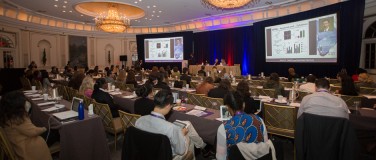
The word endometriosis had never been a part of my vocabulary; I had never heard of it as a diagnosis nor as a possible affliction neither within my own family nor in the course of normal conversation. When my adolescent daughter was experiencing periods that lasted up to two weeks and she was complaining of significant abdominal pain, enough at times to request to stay home from school, I had relied upon the information supplied by her pediatrician – that cramping was normal, and she should accept it as a normal part of being a female and to take ibuprofen for the pain. She was told repeatedly that she needed to stop complaining, to suck it up, and that she was a drama queen, that her pain couldn’t be that bad.
Toward her senior year in high school she began having migraines. After multiple doctor visits, including psychiatrists, ENT specialists, opticians, ophthalmologists and a neurologist, followed by a weekend trip to the hospital, a narcotic was administered to break the migraine cycle. The one good thing about the migraines was that people had heard of them and therefore could better understand and moreover believe the level of her pain – at least as it concerned the migraines. At some point during high school she secretly began cutting, small cuts on her inner thigh where they wouldn’t be seen. It went on for quite some time before she confessed. She couldn’t explain why, and we couldn’t imagine a reason – the predominant theme of our household was to allow our three daughters to experience childhood, to allow them to explore new interests – like gymnastics, dance, soccer, softball and bowling – where they were encouraged and supported but not pressured. She was an outstanding athlete, earning an athletic scholarship to a division 1 school and twice earning top honors at the state level. Just try to imagine what it must be like for an adolescent who is under constant siege by her body, who has seen countless doctors from multiple disciplines who have ruled out all perceived possible diagnoses, with one exception – that it’s all in her head. Even I am guilty of offending her reality, and I am the one who most understands how pain can be real yet not understood by others around you, as I have lived with Rheumatoid Arthritis for over thirty-five years. I had offered that to her on numerous occasions, encouraging her to push through the pain. Looking back on her journey I understand why she would cut herself, an attempt to validate to herself that she could indeed push through pain.
We had mixed feelings supporting her decision to go thirteen hundred miles away to attend college. During her first year away, she saw several doctors in an attempt to determine the source of her abdominal pain. One OB/GYN said she just had irregular periods and prescribed birth control (for the 2-week long periods), then changed her birth control prescription (due to still experiencing long periods) and after an ultrasound proclaimed she had follicular cysts on her left ovary (stating all women get cysts), additionally stating all women get cramps (in reference to the chronic abdominal pain). Another doctor again switched her birth control, while yet another ran down a list of possible afflictions, with endometriosis being last on his list adding it was rare and that it was unlikely she had it. She eventually found a doctor who had previous experience with endo patients, and after several ER visits for unbearable pain her new OB/GYN performed laparoscopic laser surgery to remove the offending endometrial tissue, followed by a six month round of Lupron shots. Within fourteen months the cycle repeated, with ER visits followed by surgery then Lupron. When the cycle began for a third time (and the pain was even more intense), she decided to come back home to find a specialist. It was difficult finding a doctor who had even a remote understanding of endometriosis; she was told by one OB/GYN that it was impossible to have endo pain 24/7, that she should relax and have a glass of wine! She was told by another that some people shouldn’t have surgery, that it was probably IBS or bladder issues; other doctors added acid reflux or interstitial cystitis; one even offered a pre-sacral neurectomy, a procedure that would deaden (or cut out) the nerves in the abdomen. She eventually found a doctor who seemed to have a better understanding of what endometriosis is, and that doctor said her goal was to get the level of pain down to about 2 or 3; that sounded like a marked improvement, so she had a third laparoscopic laser surgery with Lupron injections. One month later pains returned, worse than ever with new, shooting pain from her ovary down her leg. Over the next ten months (between the third and fourth surgeries) my daughter lost forty pounds, getting down to one hundred twenty-four pounds due to chronic nausea, chronic constipation, and diarrhea despite her efforts to eat healthy. We desperately needed the help of an endometriosis specialist.
We were fortunate to eventually find a doctor who had a much better understanding of why other surgeries had a tendency to fail after a relatively short period of time. He offered a minimally invasive laparoscopic surgery without the harmful effects of heat. I could see the success of the surgery the morning after, as it was the biggest and brightest I have seen my daughter’s eyes in five plus years. She could feel the difference; there was some pain from the surgery, but it was totally different than the pain she had felt after the previous three surgeries. She walked for four hours the second day after surgery (very slowly, only going 1.8 miles). In the ten weeks since the surgery she has experienced no pain, taken no prescription or over-the-counter medication (except for birth control), and had no issues with her stomach or bowels despite having no dietary restrictions. Her overall presence has dramatically changed, going from a moody, melancholy, somewhat distant person back to the funny, engaging, happy daughter I had so long ago lost.
It has been my experience throughout the past several years that the diagnosis and recommended treatment of endometriosis among medical professionals is both lacking in empathy and understanding. Many doctors who might otherwise flag a patient early as having symptoms which might include endometriosis as a possible diagnosis, are all too quick to discount symptoms as normal cramping, to which they ascribe the pain to be unfounded, a manifestation of the patient’s psyche, suggesting either ibuprofen or a psychiatrist; or conveying a possible diagnosis to be IBS, reflux or some other gastrological problem, never mentioning the possibility of endometriosis or in rare instances acknowledging the possibility but quickly dismissing it as unlikely. The problem with this approach is it takes the validity of the patient’s pain and turns it into something she must constantly defend herself against to others. When everyone in her support network is dismissive of her claims, it leads to self-doubt and a feeling of “what’s wrong with me”; withdrawal and self-injury might be predictable outcomes as the patient attempts to garner some form of control over her pain. As I became more enlightened about the disease, I began talking about my daughter’s experiences and was utterly shocked at the number of women who have endometriosis or know someone who has it and have given up, resigned to their truth that no doctor could help them. The medical community needs to receive education about endometriosis, and pay attention to the pleas of patients who have for so long been suffering.
-One caring father
*Patient stories submitted to Endofound.org are the views of the patients and not necessarily those of the foundation.









